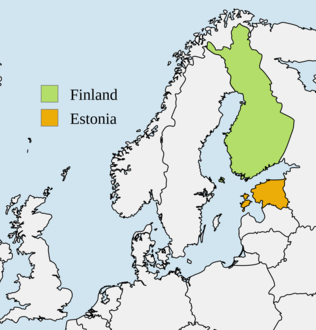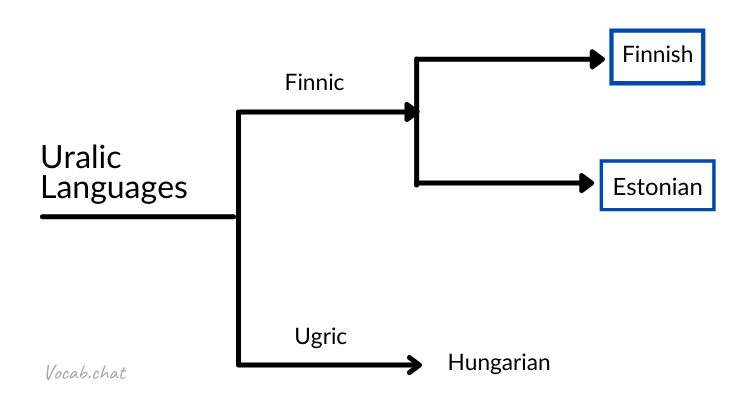Finnish and Estonian: Language Similarities and Differences

Tallinn (the capital of Estonia) is only about 50 miles south of Helsinki (the capital of Finland) across the Gulf of Finland —a branch of the Baltic Sea. It takes less than 3 hours to travel by ferry.
The geographical proximity of Estonia and Finland raises the question of whether their respective languages —Estonian and Finnish— are similar, and if so, then to what extent.
Finnish and Estonian are among the very few languages spoken in Europe which do not belong to the Indo-European family of languages.
This is a very significant fact, because of how large the Indo-European family is. It includes for instance:
- the Romance languages (French, Italian, Spanish, ..)
- the Germanic languages (English, German, Dutch, ..)
- the Slavic languages (Russian, Polish, Czech, ..)
- the Celtic languages (Irish, Welsh, Breton, .. )
- the Indo-Iranian languages (Hindi, Persian, Sanskrit ..)
Finnish and Estonian both belong to the Uralic family of languages. The Uralic languages are not part of the Indo-European family of languages.
Besides Finnish and Estonian, the Uralic languages also include Hungarian and some others which are less known (such as Mansi and Khanty).
Linguistically, Finnish and Estonian are closer to each other than they are to other Uralic languages such as Hungarian.
This is because Finnish and Estonian are both part of the Finnic branch of the Uralic languages, while Hungarian is part of the Ugric branch.

While Finnish and Estonian have a lot of similar vocabulary words (which we will see), in the case of Finnish and Hungarian the vocabulary is much less similar.
Although Estonia is included in the Baltic states (because of its geographic location) its language (Estonian) is not classified by linguists as a Baltic language.
The Baltic languages (which include Lithuanian, Latvian) are part of the Indo-European family of languages.
Finnish and Estonian: similarities and differences in vocabulary
Finnish and Estonian vocabulary words which are identical
Finnish and Estonian are similar, and closely related languages. As a result, there are many vocabulary words which are identical between the two languages.
Here is a list of Finnish and Estonian words which are the same:
| English | Estonian | Finnish |
|---|---|---|
| water | vesi | vesi |
| moon | kuu | kuu |
| money | raha | raha |
| tree | puu | puu |
| snow | lumi | lumi |
| hand | käsi | käsi |
| expensive | kallis | kallis |
| sea | meri | meri |
Finnish and Estonian vocabulary words which are similar
There are many words in Finnish and Estonian, which although not identical are quite similar.
Here is a list of Finnish and Estonian words which are similar:
| English | Estonian | Finnish |
|---|---|---|
| today | täna | tänään |
| kiss | suudlus | suudella |
| river | jõgi | joki |
| belief | usk | usko |
| night | öö | yö |
| bird | lind | lintu |
| peace | rahu | rauha |
| eye | silm | silmä |
| laugh | naerma | nauraa |
| shoes | kingad | kengät |
| clean | puhas | puhdas |
Notice the letter 'õ' in the Estonian word «jõgi»: that letter exists in Estonian but not in Finnish.
Finnish and Estonian vocabulary words that are completely different
Since Finnish and Estonian are different languages (and not different dialects of the same language) there are also many vocabulary words that are completely different between them.
Here is a list of Finnish and Estonian words which are very different:
| English | Estonian | Finnish |
|---|---|---|
| smile | naerata | hymy |
| house | maja | talo |
| art | kunst | taide |
| book | raamat | kirja |
| computer | arvuti | tietokone |
| easy | lihtne | helppo |
| privacy | privaatsus | yksityisyys |
| silence | vaikus | hiljaisuus |
| slow | aeglane | hidas |
| smart | tark | fiksu |
| seasons | aastaajad | vuodenajat |
| vegetables | köögiviljad | vihannekset |
| important | oluline | tärkeä |
| telephone | telefon | puhelin |
| love | armastus | rakkaus |
Looking at these words which are different between Estonian and Finnish, we notice that some of the Estonian words are similar to German words (for example “kunst”, “privaatsus”).
This is because Estonia was occupied by the Germans during a period of the middle ages. As a result, despite Estonian and German being languages with completely different origins, there are a number of German loanwords in Estonian.
Estonian - Finnish vocabulary false friends
In the context of languages, “false friends” are words that sound similar in both languages but have completely different meanings
Here are some Estonian - Finnish false friends to be careful of:
- A commonly known false friend is « hallitus » which means “government” in Finnish and “mold” in Estonian [1]
- « Kohtu » is another Estonian-Finnish false friend to be careful of: that word means “court of law” in Estonian, but in Finnish it means .. “uterus”.
- « Kannatus » in Estonian means “suffering”, while it means “support / endorsement” in Finnish
- « Kalju » means “rock / cliff” in Estonian, while in Finnish it means “bald / hairless”
- « Pulm » means “wedding” in Estonian, while « pulma » means “puzzle / problem” in Finnish
- « Halpa » means “cheap” in Finnish, while « halb » means “bad” in Estonian
- « Raamat » means “book” in Estonian, while « raamattu » means “bible” in Finnish
Finnish and Estonian are both genderless languages
Another similarity between Estonian and Finnish is that they are both genderless languages, meaning that grammatical gender is not present in those languages.
In particular, Estonian and Finnish both use gender-neutral pronouns. The English pronouns “he” and “she” both translate to the Finnish pronoun “hän”, and to the Estonian pronoun “ta”.
As genderless languages, Estonian and Finnish nouns don’t have genders. To an English speaker, this might not seem that noteworthy, but in many European languages every noun has a gender.
This is the case with French, where remembering the gender of French nouns can be tricky for language learners.
This is even more the case in languages such as German and Norwegian where each noun has one of 3 possible genders (feminine, masculine, and neuter).
Estonian and Finnish similarities in pronunciation
Estonian and Finnish are both languages in which the length of vowels can change the meaning of words.
Finnish distinguishes two vowel lengths (short vowels and long vowels). Estonian goes one step further and distinguishes 3 vowel lengths: in addition to short and long vowels, Estonian also has a rare "overlong" vowel length.
In some languages, long vowels are indicated by marks (diacritics) on those vowels. In Finnish and Estonian long vowels are indicated by doubling the vowels (writing it twice).
This is why Finnish and Estonian are languages in which so many vocabulary words have double vowels.
Are Estonian and Finnish hard to learn?
The U.S. Foreign Service Institute rates languages into 4 categories, based on the time it takes for diplomats who are learning those languages to reach working proficiency.
Category I languages are those which are most similar to English and take the least amount of time to learn. These include Spanish, Norwegian, and Italian.
Category IV languages are the “Super-hard languages” which are exceptionally difficult for native English speakers to learn. These include Chinese, Japanese, Korean, and Arabic.
Estonian and Finnish are similar in difficulty: they are both category III languages (“hard languages”), which means that it takes about 44 weeks (1100 class hours) to reach a working proficiency in those languages.
One of the reasons why Estonian and Finnish are difficult languages for English speakers to learn is that they both have many grammatical cases. Finnish has 15 grammatical cases, and Estonian has 14.
In Finnish and Estonian, suffixes are used to indicate grammatical cases.
ConclusionEstonian and Finnish are both very similar languages and because they are unrelated to the Indo-European family of languages, they are very different from the languages which many of us are familiar with.
We’ll end with a quote by J.R.R. Tolkien, the author of The Lord of the Rings who was also a linguist - and more precisely a philologist, meaning someone who studies the history of languages:
“It [discovering Finnish] was like discovering a complete wine-cellar filled with bottles of amazing wine of a kind and flavour never tasted before. It quite intoxicated me.”— J.R.R. Tolkien
To continue learning about the similarities and differences between Estonian and Finnish, have a look at these lists of the 1000 most common Estonian words, and the 1000 most common Finnish words.
References: (Map license)